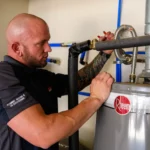Last Updated on August 4, 2024 by Asfa Rasheed
Relocating a company is a complicated choice that combines challenges and enthusiasm. The practicalities of the transfer and its effects on operations must be weighed against the prospect of better prospects, upgraded facilities, and a new beginning. Meticulous preparation and smart execution are necessary to guarantee a smooth transition.
Table of Contents
Conducting a Comprehensive Needs Assessment
Doing a thorough requirements assessment is crucial before starting the process of moving a firm. This entails assessing the business’s present and future needs to make sure the new site supports strategic objectives. Start by examining the motivations for the relocation, including any concerns about cost-cutting, market access, or growth. Knowing these driving forces helps in determining the essential requirements for the new site, including dimensions, design, and ease of access.
Both the short- and long-term requirements of the company should be taken into account in a thorough needs assessment. Analyze how much room is needed for office spaces, manufacturing spaces, and storage for ongoing activities. Make sure the new site can handle future development by considering it. Examine the new site’s infrastructure, taking into account its utilities, transit connections, and technical prowess. This in-depth analysis facilitates decision-making that upholds the goals of the company and guarantees a seamless transition.
It is essential to include stakeholders in the needs assessment process. Involve important staff members from many departments to get a variety of viewpoints and guarantee that all operational needs are taken into account. Make on-site visits to prospective sites to evaluate their appropriateness directly. This cooperative method not only helps in choosing the ideal site but also encourages staff engagement and dedication. Businesses can build a solid basis for a successful relocation that satisfies both present and future demands by doing a thorough needs assessment.
Developing a Detailed Relocation Plan
The next crucial stage is creating a thorough relocation strategy if a suitable place has been found. A well-organized plan specifies the duties, deadlines, and materials needed to carry out the relocation effectively. Forming a project team to oversee the migration, along with hiring professionals, such as these movers in Tampa, for a smooth transition should come first. To make sure that every area of the transition is addressed, this team should include members from important departments including operations, IT, and human resources.
There should be a timetable with important dates and milestones in the relocation strategy. Establish a goal relocation date first, then work backward to determine the actions that must be taken to get there. Coordinating with relocation firms, contacting stakeholders, and obtaining permissions are some examples of tasks. All tasks have to be allocated to designated team members, accompanied by well-defined roles and due dates. Frequent progress meetings allow for necessary revisions and help guarantee that the strategy remains on course.
A good relocation strategy is based on effective communication. Inform staff members of the change and how it will affect their responsibilities. Give frequent updates on the relocation’s status and quickly resolve any issues that arise. Please make sure all stakeholders, including customers and suppliers, are informed about the transition and any anticipated interruptions by keeping them updated. Creating a thorough relocation plan with open lines of communication can assist in reducing risks and guarantee a seamless transfer to the new site.
Ensuring Business Continuity During the Move
It can be very difficult to maintain company continuity during a transfer, which calls for meticulous preparation and execution. Start by determining which essential company operations need to continue throughout the move. Create backup plans for every function in case anything goes wrong. This can include putting up makeshift offices, making plans for working remotely, or contracting out certain jobs.
The use of technology is essential to maintaining company continuity. Examine the IT infrastructure and create a strategy for transferring data and systems to the new site. Make sure backup procedures are set up to avoid losing data when moving. In order to reduce downtime and handle any arising technical difficulties, collaborate with IT specialists. Maintaining smooth operations throughout the shift depends on efficient IT resource management.
Another crucial component of company continuity is customer communication. Give customers plenty of notice about the relocation and information on how it can affect services. During the relocation, designate a specific point of contact to answer questions and address issues from customers. Sustaining open and proactive communication throughout the shift guarantees that customers get excellent service and contributes to the development of trust. Businesses can reduce interruptions and preserve operational stability during the relocation process by concentrating on business continuity.
Conclusion
A company’s relocation is a complicated process that has to be carefully planned and strategically carried out. Crucial phases in the process include creating a thorough relocation strategy, guaranteeing company continuity, and conducting a thorough requirements assessment. Businesses can successfully manage the obstacles of relocation and set themselves up for success in their new setting by attending to five important areas.
Apart from this, if you are interested to know more about Choosing the Right Moving Company: A Comprehensive Guide
then visit our Business category.


























